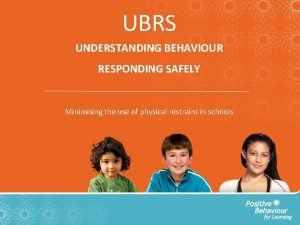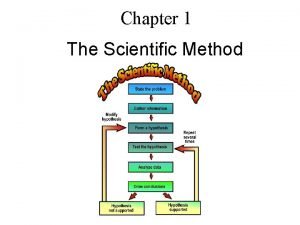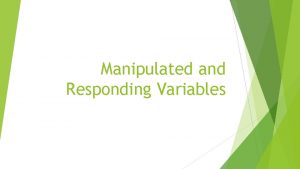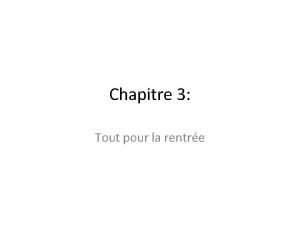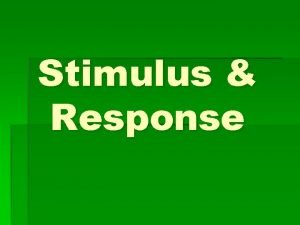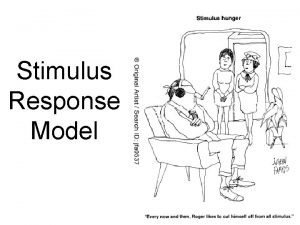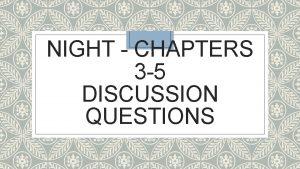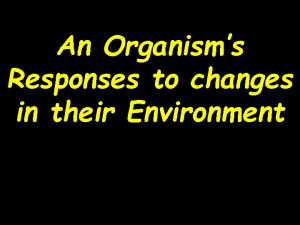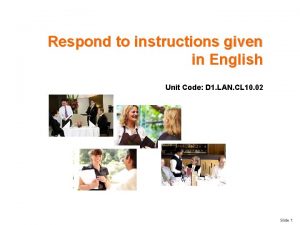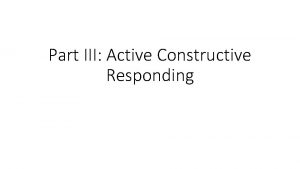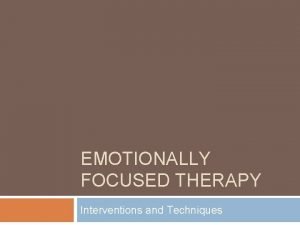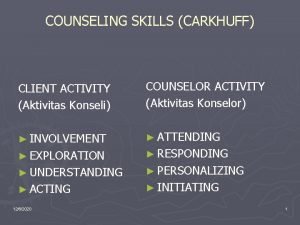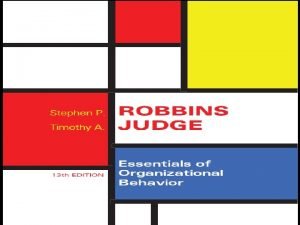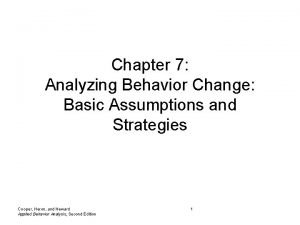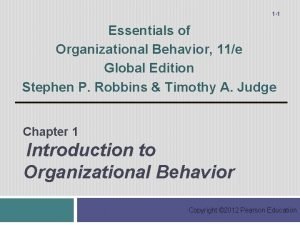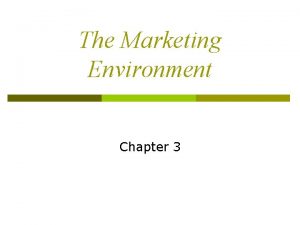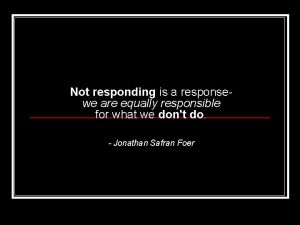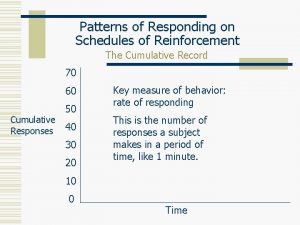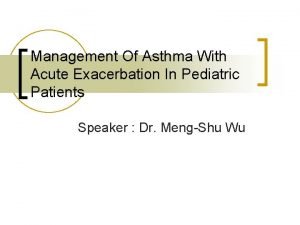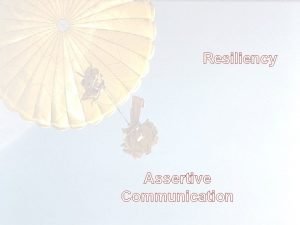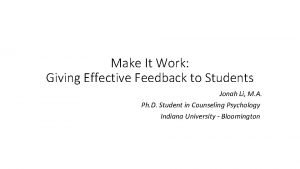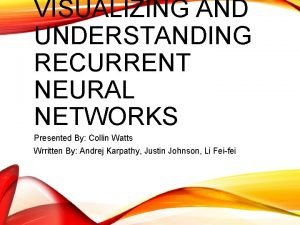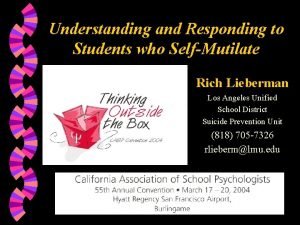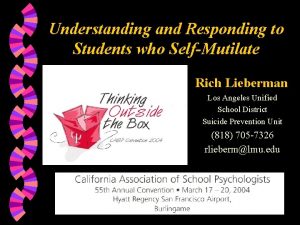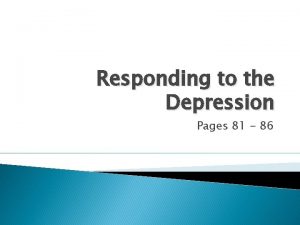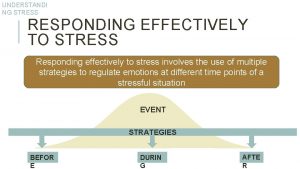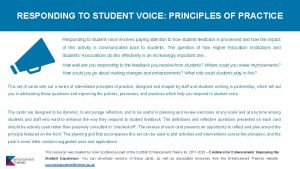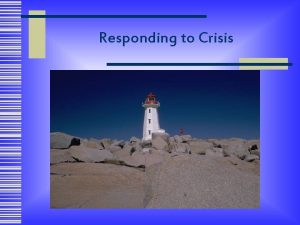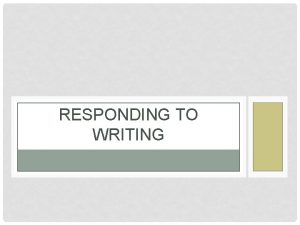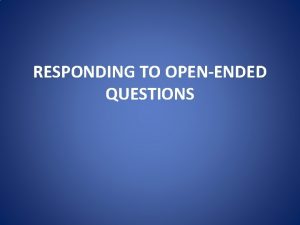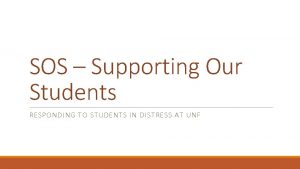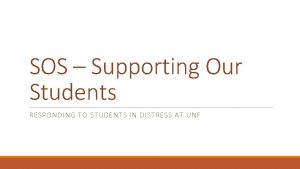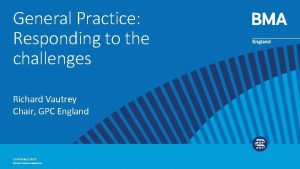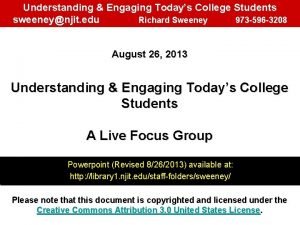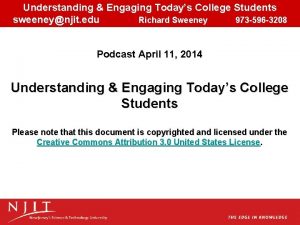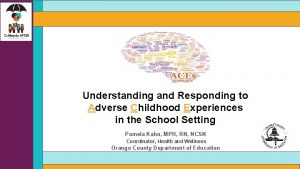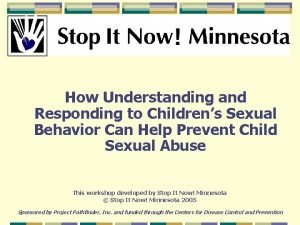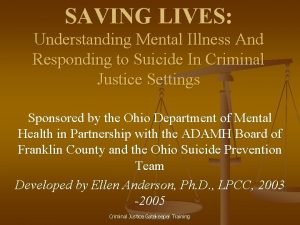Understanding and Responding to Students who SelfMutilate RICHARD










































- Slides: 42

Understanding and Responding to Students who Self-Mutilate RICHARD LIEBERMAN Los Angeles Unified School District Suicide Prevention Unit (818) 705 -7326 rlieberm@lmu. edu

Challenges to School Site Crisis Teams w Overwhelming numbers of referrals w Low risk suicide assessment w Behaviors appear contagious

Common Myths of SM Myth #1. Self-mutilators use this behavior to manipulate other people. w Myth #2. Self-mutilation is synonymous with suicide. w Myth #3. Self-mutilators are dangerous and will probably harm others. w Myth #4. Self-mutilators just want attention. w w ______________________ w Adapted from: Froeschle & Moyer (2004). Just cut it out: Legal and ethical challenges in counseling students who self-mutilate. Professional School Counseling, April, 2004.

Continuum of Self-destructive Behavior Stressors Thoughts Warning signs Behaviors SUICIDE HOMICIDE

Definitions w Inclusion of other Self-Injurious Behaviors (SIB) w Distinguish from ritual tattooing, branding and piercing w Not related to cognitive impairment

Definitions (2) “The definition of self-mutilation is that it is a direct, socially unacceptable, repetitive behavior that causes minor to moderate physical injury. ” Suyemoto&Kountz (2000) Self-Mutilation The Prevention Researcher Nov. , Vol. 7 No 4

Classifications Of Pathological Self-mutilation w Major Self-mutilation w Stereotypic Self-mutilation w Moderate/Superficial Selfmutilation

CLASSIFICATIONS: Major Self-mutilation Infrequent act that occurs suddenly, with a great deal of tissue damage and bleeding. w Most commonly associated with psychosis and acute intoxication. w Religious or sexual themes may be present. w

CLASSIFICATIONS: Stereotypic Self-mutilation “Driven by a biological imperative to harm themselves shamelessly and without guile” Favazza Most common form: head banging w Most common population: Institutionalized/psychotic w Self-injurious behaviors (SIB) w

CLASSIFICATIONS: Stereotypic Self-mutilation • Autism (head banging, lip/wrist biting) • Retts disorder (hand washing) • Tourettes (multiple simple and complex tics, variety SIB) • Use of medication is common though behavior therapy is primary modality.

CLASSIFICATIONS: Moderate/Superficial Self-mutilation w Most common: skin cutting, burning • Compulsive: Hair pulling, scratching. • Episodic: Rapid respite from distressing thoughts/emotions/tension; regain sense of self control. • Repetitive: Addiction to self harm.

Diagnosis Repetitive Self-mutilation Syndrome (RSM) RSM is recurrent failure to resist impulses to harm one’s body physically without conscious suicidal intent. Bodies Under Siege Self-mutilation and Body, Modification in Culture and Psychiatry Armando R. Favazza, M. D. Hopkins University Press Baltimore/London

Diagnosis (2) RSM can be associated with many disorders w Borderline personality disorder w Depression: mood & anxiety disorders w Post traumatic stress disorder w

Diagnosis (3) w Impulse disorders: Episodic/gratifying • Alcohol & substance abuse • Suicide attempts • Eating disorders • Repetitive self-mutilation

RSM: Prevalence & Onset w w w Onset: late childhood-early adolescence Rates higher in adolescence: approximately 1400 per 100, 000…roughly 13% Rates higher in females Rates higher in psychiatric pop. Behaviors may become chronic and persist for 5 -10 yrs. or longer if left untreated.

RSM: Predisposing Factors w w w w Onset linked to “stressful” situations Physical/sexual abuse in childhood Family violence Early history of hospitalization/surgery Parental alcoholism/depression Perfectionist tendencies/dissatisfaction with body Inability to tolerate and express emotions

RSM: Precipitating events Chaotic families characterized by divorce, neglect or deprivation of care w Loss of a parent w • Parental loss = emotional distancing and inconsistent parental warmth Physical/sexual abuse w Having a sibling who engages in SM w Witnessing family violence w

RSM: Precipitating events (2) w w w Recent loss or death Peer conflicts Intimacy problems Break up of romance Rejection of human interconnection Fear of abandonment

Functions of SM: What Do Kids Report? Want to feel concrete pain when psychological pain is overwhelming w Reduces numbness w Keeps trauma from intruding w Gets attention of others w Discharges my anger and despair w Gain a sense of control w A way to punish myself w

Functions of SM Meets a multitude of needs w Relief from overwhelming feelings w Communication w Stop inducing or preventing dissociation w Alderman, T. (1997) The Scarred Soul: Understanding and Ending Self-Inflicted Violence (New Harbinger Press, Oakland, CA. )

Functions of SM w Self-punishment: scars/blood concrete reminders w Physical expression of pain w Re-enacting previous abuse

Functions of SM Bottom Lines Euphoric feelings w Establishing control w “Self-mutilation is an active, direct, concrete representation of intense anguish. ”

Phenomenology “Although self-mutilators sometimes report feeling guilty or disgusted after an incident, most adolescents report feeling relief, release, calm or satisfaction…ending the anger, tension or dissociation. ” Suyemoto K. (1998) The functions of self-mutilation. Clinical Psychology Review, 18(5), 531 -554

Phenomenology § Isolation § Engages in SM in isolation § Masks behaviors and injury with clothes § Having friends that are not friends with each other places at greater risk § Alpha teens § Borderline personality: female § Anti-social personality: male

Phenomenology § Contagion § Teens at height of imitative behavior. “rite” of togetherness § Exposure to SM and parasuicidal behavior raises risk in youth § May spread among peer groups, grade levels, clubs § Monitoring personal reactions § Caregiver’s emotional responses to SM § Caregiver responses to student § Recognize limitations

Prevention § Protective factors § Connectedness; access to mental health; spiritual life; stable families § Crisis preparation § Crisis teams; referral procedures; updating local resources (DCFS) § Training § Psycho-education § Primary prevention programs § Depressions screening; alcohol and substance abuse; bullying

Treatments w Biological w Psychological and Social w Cognitive/Behavioral Therapy “There is no single, correct therapeutic approach. Prevention is key. ” Favazza

Treatments: Biological w Serotonin (SSRIs) • Prozac, Paxil, Zoloft • Preferred treatment for depression and anxiety disorders. • Primarily affect on impulsivity/compulsivity w FDA advisory

Treatments: Psychological and Social w Making and maintaining a relationship w Breaking the habit w Maintaining change Tantam & Whitaker (1992)

Treatments: Psychological and Social w Analyze precipitating events • Identify thoughts and emotions • Where/how wounds • Goal: Reduce tensions w Gain control over cutting Hawton (1990)

Treatments: Cognitive/Behavioral Therapy w Connection between thoughts and behaviors • Facilitated by directing attention away from environment and towards thoughts • Replace negative perceptions with focus on positive qualities. w TADS

Treatments: Dialectical behavioral therapy Pioneered by Marsha Linehan in work with Borderline personality disorder w Combination of individual, group and skills training w Hierarchical structure of treatment goals w Success in reducing parasuicidal, SM behaviors as well as reducing behaviors that interfere with therapy w

Responding to Students who Self-Mutilate Intervention w w w Advocate and educate: Create a climate of trust with the student Legal and ethical issues Identify and refer Suicide assessment Build and tighten “Circle of Care”

Responding to Students who Self-Mutilate Intervention: Suicide assessment ASSESSMENT: LOW RISK (Ideation) w Question: Have you ever thought about suicide (harming yourself)? w Observed behaviors: current or recent thoughts or depression; direct or indirect threats, sudden changes in personality, friends, behaviors; evidence of self harm through written or art work w Actions: Reassure and supervise student; warn parent; assist in connecting with school and community resources; suicide-proof environments; mobilize a support system; utilize no-harm agreements

Responding to Students who Self-Mutilate Intervention: Suicide assessment ASSESSMENT: MODERATE RISK w Previous behaviors w Question: Have you ever tried to kill (hurt yourself) before? w Observed behaviors: previous attempts, hospitalizations, trauma (losses, victimization); recent medications for mood disorders; running into traffic, jumping from high places; RSM

Responding to Students who Self-Mutilate Intervention: Suicide assessment ASSESSMENT: HIGH RISK w Current plan and access to method w Question: Do you have a plan to kill (harm) yourself today? w Observed behaviors: current plan; finalizing arrangements by giving away prized possessions or written/e-mailed good bye notes; refusal to sign no-harm agreement

Responding to Students who Self-Mutilate Intervention: Suicide assessment ASSESSMENT: MODERATE/HIGH RISK Actions: w Supervise student (including rest rooms) w Hand off ONLY : • Parent • Law enforcement • Psychiatric mobile responder w Prepare re-entry plan.

Responding to Students who Self-Mutilate Intervention w Warning parents • Obtain relevant mental health history including insurance information; traumatic losses; victimization; signed release of information w Utilize no harm agreements w w w Connectedness with adults Help–seeking behaviors Communication skills Grief resolution Provide hotlines/websites w. Hotlines: (800) SUICIDE (800) DONTCUT w. Internet selfinjury. com selfharm. org. uk selfabuse. com Google

Responding to Students who Self-Mutilate Intervention: Tension Release Get active: Exercise w Stress management techniques w • Yoga, breathing, meditation, visualization, martial arts, Tai Chi w Alternative therapies include art and play therapy

Responding to Students who Self-Mutilate Intervention: Communication skills Help seeking behaviors w Journals/drawing to aid ventilation of emotions w Play: with younger w Advocacy: reaching out to others w Cognitive behavioral approaches w

Responding to Students who Self-Mutilate Intervention: Substitute behaviors Rubber bands w Holding books out at arms length w Standing on tip toes w Substitute ice or magic marker for sharp implement v Parent permission! w

Responding to Students who Self-Mutilate References: Lieberman, R. & Poland, S. (in press). Understanding and responding to students who self-mutilate. In G. Bear & K. Minke, Children’s needs III. Bethesda, MD: National Association of School Psychologists. w Lieberman, R. (2004). Understanding and responding to students who self-mutilate. National Association of Secondary School Principals: Principal Leadership 4(7) 10 -13. w Poland, S. & Lieberman, R. A. (2002). Suicide intervention. In Thomas, A. & Grimes, J. , Best practices in school psychology IV. Bethesda, MD: National Association of School Psychologists. w w nasponline. org
 Understanding behaviour responding safely
Understanding behaviour responding safely Richard iii and looking for richard
Richard iii and looking for richard Learning targets helping students aim for understanding
Learning targets helping students aim for understanding First favorite novel of rizal
First favorite novel of rizal Manipulated variable and responding variable graph
Manipulated variable and responding variable graph Why are line graphs powerful tools in science?
Why are line graphs powerful tools in science? Congratulations is an expression of
Congratulations is an expression of The fourth step in the scientific method is
The fourth step in the scientific method is What is the manipulated variable
What is the manipulated variable Making and responding to requests 2 bac
Making and responding to requests 2 bac Responding to internal stimuli
Responding to internal stimuli Responding to internal stimuli
Responding to internal stimuli Night chapter questions
Night chapter questions High order verbs
High order verbs An indirect, dishonest way to control or influence others
An indirect, dishonest way to control or influence others Evidence crime scene
Evidence crime scene Marketing environment case study
Marketing environment case study Responding to internal stimuli
Responding to internal stimuli Responding to the environment
Responding to the environment How to respond to instructions
How to respond to instructions Joy multiplier
Joy multiplier Eft cycle
Eft cycle Cpi supportive stance reasons
Cpi supportive stance reasons Attending responding personalizing initiating
Attending responding personalizing initiating Responding to economic pressures
Responding to economic pressures Behavioral variability aba
Behavioral variability aba Complementing intuition with systematic study
Complementing intuition with systematic study Natural environment in marketing
Natural environment in marketing Not responding is a response
Not responding is a response Responding to globalization in ob
Responding to globalization in ob Responding to the marketing environment
Responding to the marketing environment Scalloped pattern of responding
Scalloped pattern of responding Transversal geometry definition
Transversal geometry definition Initiating conflict
Initiating conflict Asthma not responding to albuterol
Asthma not responding to albuterol Example of receiving in affective domain
Example of receiving in affective domain The 3 c's of assertive communication
The 3 c's of assertive communication Losada ratio
Losada ratio Tricky dicky richard nixon
Tricky dicky richard nixon Visualizing and understanding recurrent networks
Visualizing and understanding recurrent networks Visualizing and understanding convolutional networks
Visualizing and understanding convolutional networks Advanced higher art contextual analysis example
Advanced higher art contextual analysis example Sqa understanding standards art and design
Sqa understanding standards art and design
